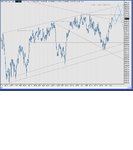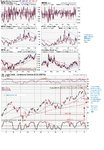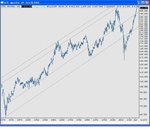good evening
The unskilled eye can see a certain number of definable highs and lows, peaks and valleys, troughs and crests - the markets will move through what should be some what predictable (what fudgestain calls gyrations.) These movements are called cycles or waves. While the markets have historically given us significant returns, the ride from one day to the next is never without some bumps.
Despite our desire to think that the public investors have a hand in market direction, their participation (as a percentage to overall ownership) is the equivalent to an umbrella in a hurricane. The institutional accounts, arbitrage firms, mutual funds and hedge funds are the real driving force behind our markets. These institutions' objective is simple: they need to outperform the indices . To do that effectively, they rely on highly-sophisticated algorithms to determine overbought and oversold conditions in the market place.
Unfortunately, by the time the individual investor perceives the buying "rally", the tide has already begun to shift. When perceiving the rally, individual investors will react to it, but, in doing so, they are "unconsciously" already starting the secondary rally, into which those big institutions are already unloading. We've all heard the slogan "buy low, sell high", but without the proper tools, guidance and advice on your side, this principle - while fundamental in concept - is virtually impossible to execute.
Understanding and evaluating overbought/oversold conditions can be a life-saver to any trader,stay alert to the overall movements of the markets not hour by hour or day to day, but in a larger picture.While overall trends will dictate an increasing or decreasing market, there will be substantial opportunities to capitalize on the wave-like movements that occur in the markets.You can then postion your self intraday if one is a day trader to trade with the trend and look for set ups
joe





